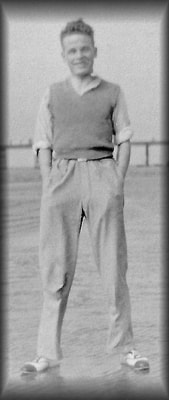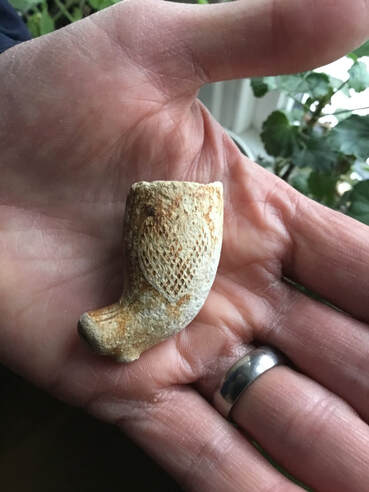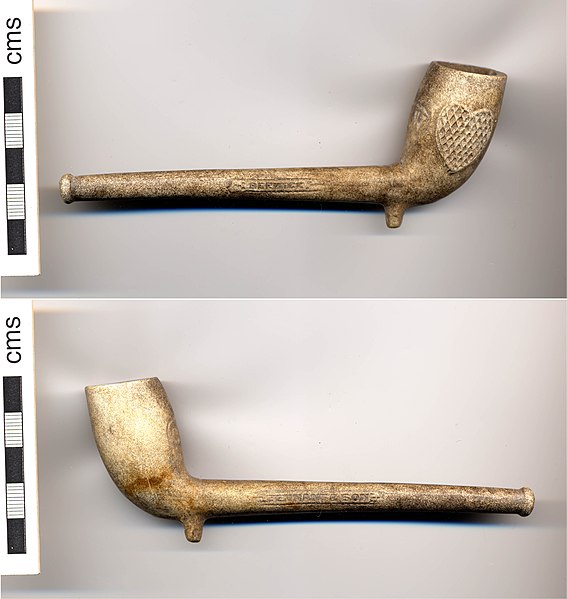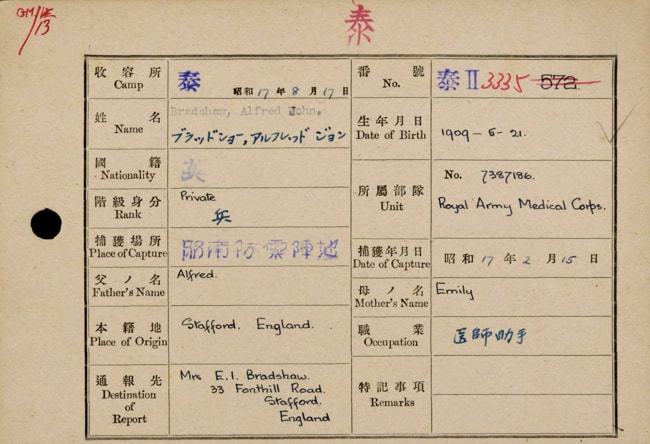|
In January we did a blog about various bits and pieces that had been found on the Town Yetholm haugh - HERE.
One of the items discussed then was an old pipe bowl. It’s easy to find bits from old clay pipes scattered all around Yetholm – mainly bits of pipe stem, with an occasional bowl fragment. Chris Burton and his daughter, rummaging around in the gravel along the Bowmont Water, have recently found the example shown above. For once this is rather more interesting than the usual plain fragment, being decorated with a heart shape. Similar decorated pipe bowls to be found on the internet make a variety of claims about the symbolism. Sometimes the heart is coupled with an image of hand with a smaller heart held in its palm. Some claim this as a patriotic Irish emblem - the hand-holding-a-heart being the Red Hand of Ulster. Others claim it is a masonic icon, linked to the Oddfellows. The source for such ideas are unclear. Unfortunately the internet generates and duplicates a lot of unchecked guesswork. On the other hand ... the internet also threw up the photograph shown below - from Wikimedia Commons - HERE. The notes that go with it read: English: A white pipe clay tobacco pipe, dating to the mid nineteenth century. The pipe is complete and does not appear to have been used. The stem is stamped with the words 'TENNANT & SON' and 'BERWICK'. The bowl is stamped with the initials 'TW' within an oval depression. There is a raised heart motif on one side of the bowl. The heart motif is decorated with cross hatching. The pipe has a small circular section spur. The bowl has a diameter of 23mm and a height of 42mm. The stem has a maximum diameter of 10mm. The pipe as a whole is 133mm in length. Whatever the symbolism of the heart it seems highly likely, given the location of the find, that Chris's pipe was also made by Tennant and Son of Berwick and would have looked exactly the same when complete. As with the example found on Wikimedia, the pipe bowl found on the haugh was only decorated on one side, displaying a heart and no hand. Who knows what it was meant to symbolise - perhaps simply that the owner loved to smoke and dream?
0 Comments
 The 1939-45 period is only sparsely recorded in our archives - men were away from home, few tourists visited and sent postcards, there was a general news blackout... It was interesting, therefore, to be contacted recently by Phil Bradshaw in connection with his grandfather Alfred Bradshaw (left), who found himself stationed in the village for several months in the Spring of 1941. Phil writes: Alfred Bradshaw was originally from Stafford, and joined up a few months earlier. He had originally been with a different unit and was moved up from Leeds. When based at Yetholm he was with Army Medical Corps, as part of the 196th Field Ambulance unit. They started to arrive towards the end of 1940 (but the unit was still forming at this time). There would have been around 200 men from this particular RAMC unit there. By April of '41 they had moved to a place near Bury, Lancashire. Alfred's service record, with references to Yetholm, is shown below. One wonders why Yetholm was chosen for this unit and what kind of training the men received here - and where 200 men could have been accommodated? Phil writes that: 'I'm not sure where they stayed, another member of the unit says that a few of them were first put up at the village hall for a night or two, before going on to proper quarters.' The 'village hall' must have been the Wauchope Hall, but where were these 'proper quarters'?
Phil has also sent us a memory of their time in Yetholm by another member of the 196th Field Ambulance Unit, Alan Nixon: We were drafted to the Scottish Border village of Yetholm, and it was a great billet in the winter of 1940-1. The people were very kind to us and we made many friends. We used to go to the village pub for a pint and a Scottish pub-goer there nearly always treated us to a Drambui each as a chaser, my first introduction to it, which has led to a life-long love of the stuff. We had daily marches and drilled around the village during which times we had to suffer snowballing attacks from the local kids. This countinued until the NCO in charge of us got fed up and said "right lads" and we turned around and gave chase with a barrage of our own. Then as a treat we trooped back to the local bakers to sample the freshly-baked bread. It was certainly a happy three or four month period in Scottish Yetholm. We left there in Spring when the Border hills were looking their best, with some sense of regret. These happy memories contrast with the subsequent grim fate of the unit. They were sent to Singapore and were taken prisoner by the Japanese in February 1942. Many of them never returned home, although Alfred was liberated in Thailand in August 1945 and arrived back in Southampton in October of that Year. A prison index card from his time as prisoner of the Japanese is shown below. It is somewhat ironic that one the few records we have relating to Yetholm in the WW2 period is about a German prisoner - a subject for a later blog - who was held here (and worked on local farms), while men from Britain were scattered elsewhere around the world. |
Archives
July 2024
|




 RSS Feed
RSS Feed
